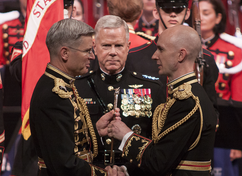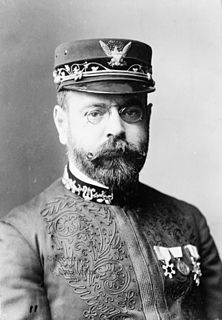
John Philip Sousa was a Portuguese-American composer and conductor of the late Romantic era known primarily for American military marches. He is known as "The March King" or the "American March King", to distinguish him from his British counterpart Kenneth J. Alford. Among his best-known marches are "The Stars and Stripes Forever", "Semper Fidelis", "The Liberty Bell", "The Thunderer", and "The Washington Post".
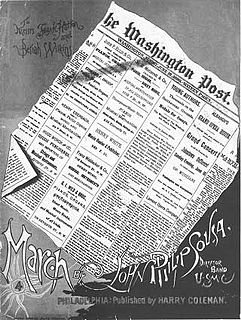
"The Washington Post" is a march composed by John Philip Sousa in 1889. Since then, it has remained as one of his most popular marches throughout the United States and many other countries.

The United States Marine Band is the premier band of the United States Marine Corps. Established by act of Congress on July 11, 1798, it is the oldest of the United States military bands and the oldest professional musical organization in the United States. Today, the Marine Band includes the Marine Chamber Orchestra and Marine Chamber Ensembles.
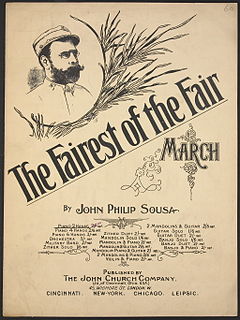
"The Fairest of the Fair" is a 1908 march by John Philip Sousa. One of Sousa's more melodic, less military marches, it was composed for the annual Boston Food Fair of 1908. It is claimed that the memory of a pretty girl he had seen at an earlier fair inspired the composition.

Major-General Joseph Robert Davis was an American politician and lawyer who served as the commanding general of the Mississippi National Guard from 1888 to 1895. During the American Civil War, he served as aide-de-camp to the President of the Confederate States and commanded a brigade in the Army of Northern Virginia. He is best known for his role at Gettysburg. A member of the Democratic Party, he represented Madison and Scott counties in the Mississippi Senate from 1860 to 1861.
"The Gladiator" is a march by John Philip Sousa, written in 1886 while Sousa was leader of the US Marine Band.

Stars and Stripes Forever is a 1952 American Technicolor film biography of the late-19th-/early-20th-century composer and band leader John Philip Sousa. This 20th Century Fox feature was produced by Lamar Trotti, directed by Henry Koster, and stars Clifton Webb, Debra Paget, Robert Wagner, and Ruth Hussey. The film's title is taken from Sousa's "The Stars and Stripes Forever", which has become the best known of his military marches. The film was released twenty years after Sousa's death.

"Semper Fidelis", written in 1888 by John Philip Sousa, is regarded as the official march of the United States Marine Corps. This piece was one of two composed in response to a request from United States President Chester Arthur for a new piece to be associated with the United States President. The words Semper Fidelis are Latin for "Always Faithful." The piece was created for a wind band in addition to a percussion section. There is a very prominent drum solo in the middle of the piece which includes a skillful dynamic change. It features staccato notes and sharp tonguing.
Allan R. Millett is a historian and a retired colonel in U.S. Marine Corps Reserve. He is known for his works on the Korean War, but he has written on other military topics.
"The Royal Welch Fusiliers" is a march composed by John Philip Sousa in 1929, and then rewritten in 1930. It is the only march written by Sousa for a British Army regiment.
Paul Edmund Bierley was an American music historian. Among his awards were a Society for American Music Lifetime Achievement Award and receiving an Honorary Doctor of Music from Ohio State University.

Marcella Lindh was the stage name of an American soprano singer who was Rose Jacobson Jellinek in private life.

"In Memoriam: President Garfield's Funeral March" is a funeral dirge composed by John Philip Sousa in 1881, while serving as director of "the President's Own" United States Marine Band, for the state funeral of President of the United States James Garfield. It was debuted during the committal of Garfield's remains and, 51 years later, was performed at Sousa's own funeral by the Marine Band. It is one of only two compositions Sousa dedicated to an American president, the other one being "President Garfield's Inauguration", both of which were made to Garfield.

Nicoline Zedeler, later Nicoline Zedeler-Mix, was a Swedish-born American violinist who toured as a soloist with John Philips Sousa.
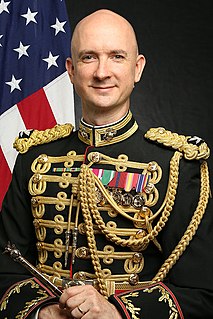
Jason K. Fettig is a United States Marine Corps colonel who is the music adviser to the President of the United States and the 28th director of the United States Marine Band.

"Nobles of the Mystic Shrine" is a march composed by John Philip Sousa upon the request of his nephew, A. R. Varela. Sousa dedicated the march to the Almas Temple and the Ancient Arabic Order of the Nobles of the Mystic Shrine. It was first conducted in June 1923, with a band of around 6,200 members—the largest Sousa had ever conducted. It is one of the few Sousa marches with the first strain written in the minor mode. Contemporary versions of the march recorded by the Ottoman military band also use the Jingling Johnny in the final strain.

Boy Scouts of America is a march composed by John Philip Sousa in 1916 upon the request of Charles D. Hart. Sousa dedicated it to the Boy Scouts of America. It was premiered in October 1916 at the Metropolitan Opera House. The cover sheet features a photograph of a statuette R. Tait McKenzie's The Ideal Scout. It is considered one of the best marches Sousa ever composed, with The Reading Times writing that the march proved that the "noted composer still retains the name of 'March King'".


